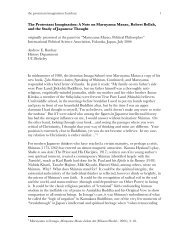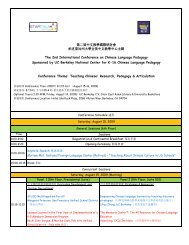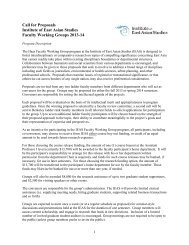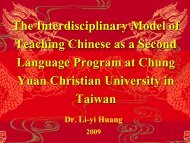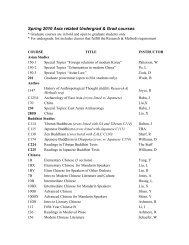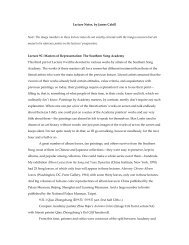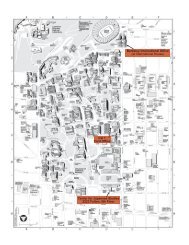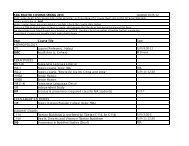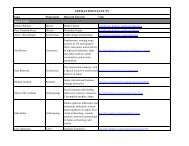Third Edition Spring 2013 - Institute of East Asian Studies, UC ...
Third Edition Spring 2013 - Institute of East Asian Studies, UC ...
Third Edition Spring 2013 - Institute of East Asian Studies, UC ...
You also want an ePaper? Increase the reach of your titles
YUMPU automatically turns print PDFs into web optimized ePapers that Google loves.
political struggle for the working class and laborers. 30 In addition,the communist leadership has refined the meaning <strong>of</strong> photographyto the state as serving to “highlight the atmosphere <strong>of</strong> enthusiasm,happiness, and the devotion <strong>of</strong> their work (Vietnamese photographers),the goal <strong>of</strong> which is to contribute forces for the constructionand development <strong>of</strong> the fatherland.”” 31Evidence <strong>of</strong> New Relationshipto Culture ProductionThe 25th National Photographic Exhibition captures Vietnam’schanged mode <strong>of</strong> culture production. This exhibition eventwas jointly organized between the Ministry <strong>of</strong> Culture, Sports andTourism in Vietnam and the Vietnam Association <strong>of</strong> Art Photographersin welcoming the 63rd anniversary <strong>of</strong> the National Day <strong>of</strong> theSocialist Republic <strong>of</strong> Vietnam. 32 The topic chosen was “The Beauty<strong>of</strong> the Vietnamese Land and People.” This topic choice reflects thecountry’s new aim <strong>of</strong> highlighting a “timeless beautiful landscape”that is attractive to tourists, as well as its effort to establish the nation’sphotography in the international arena. 33The government’s efforts to promote its beautiful landscapeand to establish itself as a force in the international photographyarena are also exemplified in the creation <strong>of</strong> the International ArtPhoto Contest. This contest was created and hosted in Vietnamin 1996 and is regularly held in the country every few years. Thecompetition attracts over a thousand photographers from over 36different countries with photos being judged by an internationaljury, while the event has been selected as one <strong>of</strong> the top ten outstandingcultural events <strong>of</strong> the year. 34 The photos that are <strong>of</strong>ten30 Lê, Phức, and Thành, Chi. Ảnh Việt Nam Thế Kỷ XX = Vietnamese Photographyin the 20th Century = La Photographie Du Vietnam Au 20e Siècle. Hà Nội: Nhà Xuất BảnVăn Hoá Thông Tin, 2002.31 Triển, Lãm and Thứ, Nghệ. The 25th National Photographic Exhibition. Bộ VănHóa, Thể Thao Và Du Lịch, 2008.32 Ibid.33 Tai, Hue-Tam Ho. The Country <strong>of</strong> Memory: Remaking the past in Late SocialistVietnam. Berkeley: University <strong>of</strong> California, 2001.34 Phuc, Le. Vietnam 2002: The Second International Art Photo Contest in Vietnam.awarded medals in the competition capture landscape, wildlife,portraits, and are sometimes simply aesthetically pleasing . Whilethe competition is an exhibition that could never have existed beforeDoi Moi, after only ten years <strong>of</strong> reform, the contests highlightsthe nation’s new efforts <strong>of</strong> culture production both domesticallyand internationally. The photos themselves are no longer aimedat supporting post-revolutionary aspirations following formulaichistorical narratives, but are aimed at engendering internationalinterest.ConclusionPhotographs serve as powerful evocations <strong>of</strong> historical experiencesbecause <strong>of</strong> the way they leave an imprint on their viewersat the visual, psychological, and political levels. 35 This powercan serve governments well when constructing a national identity,as photos chosen can be used to evoke identity. In Vietnam the use<strong>of</strong> imagery to evoke historical memories has been demonstratedby the proliferation <strong>of</strong> selected photos during and after the VietnamWar. The images chosen were aimed at promoting a heroichistorical narrative <strong>of</strong> a nation that fought <strong>of</strong>f foreign invaders.The Vietnam War has been frequently referred to as the“television war” in the United States, though it may be more accurateto describe it as the celluloid war due to the significant impactphotos had in shifting public opinion, as well as photography’savailability to both sides in the war, as very few Vietnamese ownedtelevisions. 36 This “celluloid war” should continue as Vietnam’spolitics continue to liberalize. As Vietnam’s integration into the internationalarena begins to solidify following the Doi Moi reforms,photography will play an increasingly prominent role in politicalcritique. As an art market develops and tourism beckons, internationalforces will create a much more open space for revisitingthe past. The communist heroic narrative will become increasing-Ed. Vu Huyen. Ho Chi Minh City: ITXA, 2002.35 Kuhn, Annette, and McAllister, Kristen. Locating Memory: Photographic Acts.New York: Berghahn, 2006.36 Ibid.37 Mark Portillo Constructing “Culture” 38




